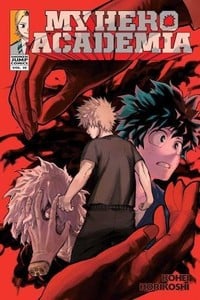Review
by Nick Creamer,My Hero Academia
GN 10
| Synopsis: |  |
||
Right in the middle of their summer training camp, Midoriya and his classmates find themselves attacked by the League of Villains! After just barely surviving his own battle, Midoriya soon learns these villains are on a very specific quest: the abduction of several of his classmates. And when Bakugo is actually stolen away by the league, the entire hero academy will have to answer troubling questions about the strength of their organization. With Shigaraki's allies striking greater and greater blows against the pillars of this heroic world, it seems possible that society at large is in for a sudden drastic shift. Midoriya may be on the path to becoming a hero, but forces beyond his control may destroy that path altogether. |
|||
| Review: | |||
My Hero Academia's ninth volume represented a dramatic and aesthetic peak for this thrilling story. Finding themselves hunted by the League of Villains while away on their training retreat, Midoriya and his classmates were forced to rally back in a dazzling display of action choreography and superpowered spectacle. Like the sports festival before it, volume nine demonstrated the full extent of Kōhei Horikoshi's artistic and action storytelling abilities. Now in the tenth volume, we open with the final stages of that battle, as Bakugo is abducted, Midoriya is left nearly broken, and the whole world has to face the fact that society's guardians may not be up for this task. That sense of worldly consequence stands as a key thread in this comparatively restrained volume. After Bakugo is stolen by the villains and many other UA students are injured, the academy's faculty are actually forced to publicly explain themselves and work to restore public confidence in their ability to maintain the peace. Sequences like the school principal defending his school's security measures at a public press conference nicely enhance both My Hero Academia's sense of dramatic consequence and its cohesion as a living world. Midoriya's conflicts have often felt constrained to a fairly self-contained, school-focused scale, making this volume's larger focus both a welcome expansion of scope and a smart way of illustrating just how precarious these heroes' positions really are. That shift in focus is accompanied by a matching shift in conflict. After a full volume focused on one impactful, multi-chapter battle after another, this volume is more concerned with recovery and strategizing, as both the students of UA Academy and their teachers form plans to strike back at the League of Villains. This results in less immediate excitement and fewer opportunities for striking visual setpieces, but trading off immediate thrills for key worldbuilding and characterization feels like the right choice for the story as a whole. By the end of this volume, it's impossible to see the heroes' grasp on this society as anything but tenuous, with Shigaraki's formerly idle boasts now seeming reflective of how this world never internalized the instability of a superpower-laden society. While UA's teachers grapple with the societal implications of their failures, Midoriya and his friends are forced to contend with their more immediate powerlessness. Bakugo's abduction gives his quasi-friend Kirishima a chance to stand out, while Yaoyorozu is able to build on her small arc from the final exams chapters to stand as an equal member of Midoriya's main crew. There's a wonderfully silly segment involving Midoriya and his friends all adopting public disguises, and a fair amount of effective chemistry between all the characters we've come to know best. Having spent nine volumes building up the distinctive personalities of Ida, Midoriya, and the other 1-A students, this volume's major conflict offers plenty of opportunities for them to demonstrate their dynamic and often frictious relationships. The best of that material comes up when Kirishima proposes they actually chase after Bakugo themselves. While Midoriya expresses support for this plan, Ida vehemently denounces it, leading up to a moment where Ida straight-up punches Midoriya. Ida's journey from the boy tracing his brother's footsteps to the young man standing as a hero in his own right has been a pleasure, and watching him fight back against Midoriya's selfish kind of selflessness feels like a well-earned payoff to a long-building personal story. My Hero Academia's characterization can sometimes feel thin, but seeing Ida bitterly rail against Midoriya's “little vigilante act” is a perfect encapsulation of how well this story treats its principal characters. On the whole, this volume represents a graceful segue into a new dramatic mode, where My Hero Academia's big dramatic shifts will prompt consequences not just for Midoriya, but for society as a whole. As this volume comes to a close, the League of Villains have just struck their greatest blow yet, with only All Might standing between an old villain and a new world. If My Hero Academia can maintain this sense of large-scale consequence, its future highlights will be more dazzling than ever before. |
| Grade: | |||
|
Overall : B+
Story : A-
Art : B+
+ Successfully transitions My Hero Academia's conflict to a larger scale, great character work for Midoriya and his friends |
|||
| discuss this in the forum (1 post) | | |||
| Production Info: | ||
|
Full encyclopedia details about Release information about |
||